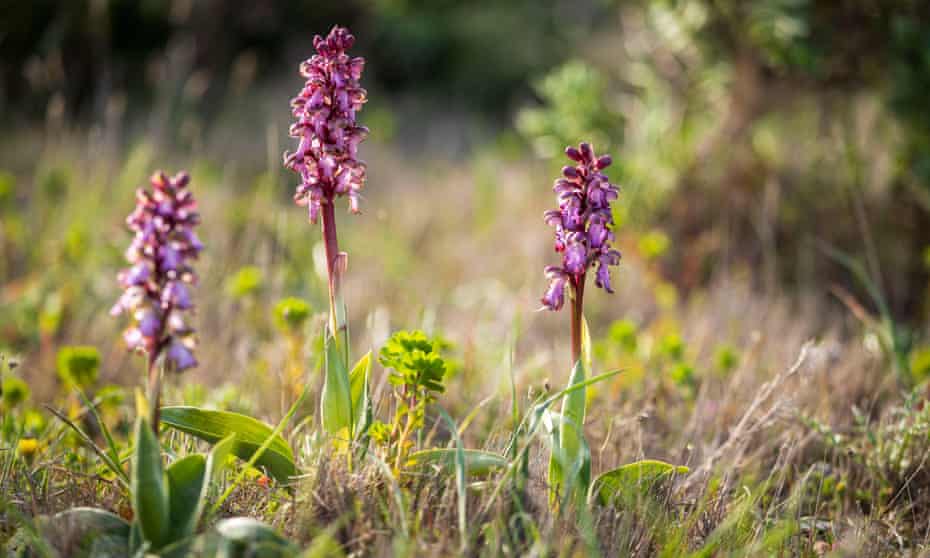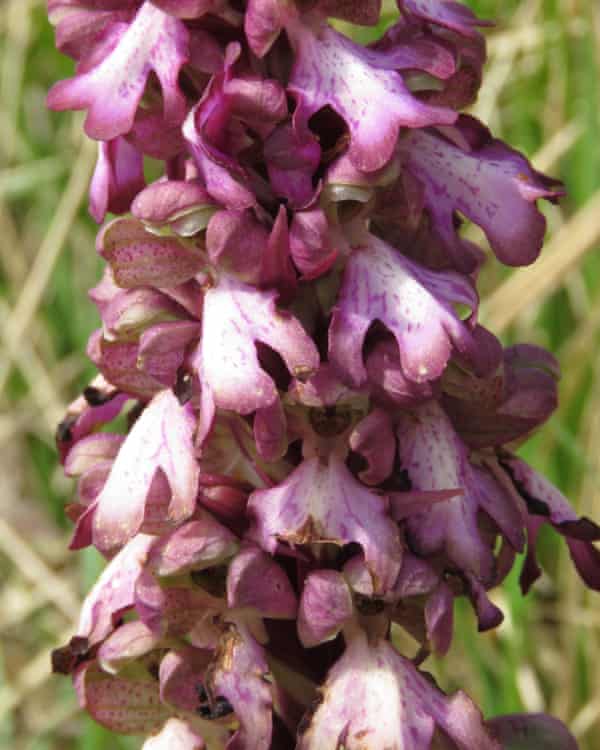Range typically found in southern and central Europe is expanding north as climate warms

Giant orchids (Himantoglossum robertianum) in France. The flowers are typically found in southern and central Europe. Photograph: Hemis/Alamy
Phoebe Weston
THE GUARDIAN
Phoebe Weston
THE GUARDIAN
Fri 1 Apr 2022
Giant orchids that can reach a metre tall have officially been found growing wild in the UK for the first time, having become established hundreds of miles north of their native range in the Mediterranean.
The “stately” plants were discovered on a grassy slope near Didcot in Oxfordshire by Hamza Nobes, a 29-year-old trainee nurse, who wishes to keep the exact location a secret.
Nobes was out on a walk when he saw the pink flower five metres away from the path and assumed it was a butterbur, but clambered down the steep slope to get a better look, and then realised what he had found. The sweet-smelling orchid has many flowers on its stem, which are purplish-red in colour, and the leaves are broad and glossy.
“I was ecstatic. I’ve never really found anything, and I’m not a botanist in any way shape or form,” said Nobes, who has been interested in orchids for two years.
Typically found in southern and central Europe, the giant orchid (Himantoglossum robertianum) range is expanding north as the climate warms, with records showing the plant is able to survive in northern France and the Netherlands.
“It was weird, because a few weeks prior I was looking through my European orchid book and I was looking at the giant orchid and thought that’s such a beautiful orchid, it would be lovely to see one day, maybe in Greece or somewhere, but really it was just 10 minutes from my house,” he said.

Giant orchids that can reach a metre tall have officially been found growing wild in the UK for the first time, having become established hundreds of miles north of their native range in the Mediterranean.
The “stately” plants were discovered on a grassy slope near Didcot in Oxfordshire by Hamza Nobes, a 29-year-old trainee nurse, who wishes to keep the exact location a secret.
Nobes was out on a walk when he saw the pink flower five metres away from the path and assumed it was a butterbur, but clambered down the steep slope to get a better look, and then realised what he had found. The sweet-smelling orchid has many flowers on its stem, which are purplish-red in colour, and the leaves are broad and glossy.
“I was ecstatic. I’ve never really found anything, and I’m not a botanist in any way shape or form,” said Nobes, who has been interested in orchids for two years.
Typically found in southern and central Europe, the giant orchid (Himantoglossum robertianum) range is expanding north as the climate warms, with records showing the plant is able to survive in northern France and the Netherlands.
“It was weird, because a few weeks prior I was looking through my European orchid book and I was looking at the giant orchid and thought that’s such a beautiful orchid, it would be lovely to see one day, maybe in Greece or somewhere, but really it was just 10 minutes from my house,” he said.

One of the orchids found on a grassy slope near Didcot. Photograph: Ian Denholm/Handout
It is not believed these plants arrived naturally, but rather by someone scattering seeds about 15 years ago, a practice discouraged by ecologists as it can result in invasive species. It is believed this is also how the species reached the Netherlands. In both cases, they managed to establish and are now reproducing themselves.
Locals say the plants flowered years ago and then vanished, but no official report was ever made. This year – perhaps benefiting from the sunny spring – there are nine flowering plants and 10 non-flowering plants, reaching a maximum of 30cm tall.
“It’s a very exciting find,” said Prof Ian Denholm, from the University of Hertfordshire, who is one of the UK’s two national orchid referees and visited the site to verify the find. “There was a [giant orchid] seen about 15 years ago, it wasn’t widely reported and it came as news to me in fact … it was never really made public, and the plant itself presumably didn’t last very long,” said Denholm.
Orchid flowers consist of three outer sepals and three inner petals, and in many species, one of the petals is highly modified as a lip to attract pollinators and give them a place to land. The giant orchid lip has lobes that fancifully resemble arms and legs, says Denholm. “It’s a very stately orchid. It lives up to its name of giant orchid. It’s got quite a long and dense flower spike.”
Orchids are good at telling us about the consequences of global heating, because there are so many orchid enthusiasts out recording changes in their range over time. Given the expansion of its range, experts say it’s feasible the giant orchid may have naturally colonised the UK at some point in the future.
There have been other reports of the tiny seeds of European orchid species blowing over the Channel to the southern counties of the UK, where they are increasingly able to survive. Last year, a colony of small-flowered tongue orchids – thought to be extinct in the UK – were discovered on the rooftop of an investment bank in the City of London. They are typically associated with central and southern Europe, and it is not known how the seeds arrived there.
“I always welcome new stuff,” said Sean Cole, a field naturalist and co-author of Britain’s Orchids. He said the find was another indication that our climate can increasingly support Mediterranean species. “We’ve got 53 or 54 species of orchids anyway, anything new is nice to have. It’s not really going to impede on anything else around it or take over. It comes from the near continent, so it’s kind of semi-natural to us, it’s not going to take over like Japanese knotweed or something.”
The orchid, which flowers in March, has proven a hit with early pollinators, including bumblebees, which have been seen on the flowers. “Our local bees have welcomed them, so then why shouldn’t we?” said Cole.
The Botanical Society of Britain and Ireland has a network of people who maintain local records and has been made aware of the discovery. Giant orchids are a non-native plants, so have no statutory protection. Orchid enthusiasts are now in communication with the owner of the site and are discussing how best to protect it.
It is not believed these plants arrived naturally, but rather by someone scattering seeds about 15 years ago, a practice discouraged by ecologists as it can result in invasive species. It is believed this is also how the species reached the Netherlands. In both cases, they managed to establish and are now reproducing themselves.
Locals say the plants flowered years ago and then vanished, but no official report was ever made. This year – perhaps benefiting from the sunny spring – there are nine flowering plants and 10 non-flowering plants, reaching a maximum of 30cm tall.
“It’s a very exciting find,” said Prof Ian Denholm, from the University of Hertfordshire, who is one of the UK’s two national orchid referees and visited the site to verify the find. “There was a [giant orchid] seen about 15 years ago, it wasn’t widely reported and it came as news to me in fact … it was never really made public, and the plant itself presumably didn’t last very long,” said Denholm.
Orchid flowers consist of three outer sepals and three inner petals, and in many species, one of the petals is highly modified as a lip to attract pollinators and give them a place to land. The giant orchid lip has lobes that fancifully resemble arms and legs, says Denholm. “It’s a very stately orchid. It lives up to its name of giant orchid. It’s got quite a long and dense flower spike.”
Orchids are good at telling us about the consequences of global heating, because there are so many orchid enthusiasts out recording changes in their range over time. Given the expansion of its range, experts say it’s feasible the giant orchid may have naturally colonised the UK at some point in the future.
There have been other reports of the tiny seeds of European orchid species blowing over the Channel to the southern counties of the UK, where they are increasingly able to survive. Last year, a colony of small-flowered tongue orchids – thought to be extinct in the UK – were discovered on the rooftop of an investment bank in the City of London. They are typically associated with central and southern Europe, and it is not known how the seeds arrived there.
“I always welcome new stuff,” said Sean Cole, a field naturalist and co-author of Britain’s Orchids. He said the find was another indication that our climate can increasingly support Mediterranean species. “We’ve got 53 or 54 species of orchids anyway, anything new is nice to have. It’s not really going to impede on anything else around it or take over. It comes from the near continent, so it’s kind of semi-natural to us, it’s not going to take over like Japanese knotweed or something.”
The orchid, which flowers in March, has proven a hit with early pollinators, including bumblebees, which have been seen on the flowers. “Our local bees have welcomed them, so then why shouldn’t we?” said Cole.
The Botanical Society of Britain and Ireland has a network of people who maintain local records and has been made aware of the discovery. Giant orchids are a non-native plants, so have no statutory protection. Orchid enthusiasts are now in communication with the owner of the site and are discussing how best to protect it.
No comments:
Post a Comment